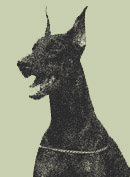1. DCM - Dilated cardiomyopathy
is an acquired disease that is characterized by a markedly enlarged and weakened heart muscle. In the Doberman it affects mainly
the left ventricle and left atrium. It results in electrical abnormalities (irregular or abnormal or premature beats).
These electrical abnormalities may result in sudden death of the dog. Affected dog can die at any time from 2 months up to over 9 years of age.
The mechanism of inheritance is not quite clear. According to van der Zwan 1987 the age of DCM death depends on the number of inherited DCM genes.
According to the University of Guelph 50% of all symptom free Dobermans will develop DCM. Similar results were demonstrated by the University of Georgia.
Males are more affected (60% will develop DCM) than females (40%).
The average age that Dobermans develop symptoms of DCM is 7.5 years of age. However 25% of our dogs developed symptoms of DCM over 10 years of age.
Dobermans may manifest one of two common symptoms related to DCM.
Respiratory distress, usually noted as a cough, wheeze, or labored breathing, is the most common symptom of DCM.
The next common symptom is called sudden death. In sudden death owners usually observe that their dog was running
in the yard then collapsed and died. A third of all Dobermans destined to develop
DCM will experience sudden death as the first symptom of their disease.
.
Diagnosis of the dog’s arrhythmia is possible by using long-term 24-hours
ECG (Holter recording). Holter exam determines,
if an apparently normal Doberman has reached the second stage of DCM (occult DCM) or if the dog is at risk for developing sudden death.
The diagnosis of occult DCM can be difficult. These dogs are free of symptoms of heart disease, that is the owners believe their dogs are normal.
The ideal tools to identify these dogs are cardiac ultrasound, routine ECG, and Holter monitoring.
Cardiac Ultrasound reveals:
· Left ventricular enlargement: in diastole > 49 mm, or in systole > 42 mm. Note that these measurements can vary tremendously depending on the experience of the technician that generates this data.
Routine ECG is a 3 to 6-minute rhythm trace. This reveals:
· At least 1 PVC/min. in most dogs. (PVCs refer to premature ventricular contractions.)
24-hour Holter reveals:
· As of today, the Holter Project at the University of Guelph believe a level of more than 50 PVCs per hour indicates Dobermans affected with occult DCM.
2. Volvulus (Bloat and Gastric Torsion)
The heredity pattern is not yet exactly known. Bloat requires for immediate medical
attention. It is usually seen in male dogs between 4 and 7
years of age who eat large quantities of dry kibble, exercise
vigorously after eating, and drink lots of water after eating.
One possible way to prevent bloat is to crate the dog (or keep
calm) for at least an hour after eating.
3. Hypothyroidism
According to Dodds (1988), over 60 % of Dobermans in
the USA are hypothyroid. Symptoms in the dog may include hair and skin illnesses,
muscle and nervous diseases, loss or gain of weight, digestive troubles, infections and other symptoms.
Quality of life and life expectancy are greatly reduced without hormone treatment.
The heritability of hypothyroidism is estimated to
be as high as 90 percent (Dodds 1988).
4. von Willebrand disease (= vWD-bleeder) The “von Willebrand disease” is a very special blood
coagulation disorder with a significant health risk.
In the American Dobermans the vWD gene frequency
is very high:
30% are homozygote affected,
50% are carriers heterozygote vWD,
20% are clear and homozygote free (Kurz 2004).
Presently the European
Dobermans are only lightly affected by vWD genes but exact figures are unknown.
5: Wobbler syndrome (paralysis) The Wobbler syndrome is
a hereditary degenerative disease
of the neck spinal column, occurring most commonly in middle
age. Displacement of one vertebra in relation to another.
The American Doberman has a
higher occurrence than the European. However, exact figures
are known neither for North America nor for Europe.
6. Degenerative eye diseases (PHTVL/PHPV) Impaired vision up to full loss of the sight is the result of genetic
Condition. Currently most of the European dogs are tested for PHTVL/PHPV prior to breeding.
7. Hip joint dysplasia –HD, (crippling arthritis and hip pain).
Since the beginning of the X-ray examination most of the Dobermans in Europe are free from Hip dysplasia.
Resourses:
Increasing Hereditary Health Problems in the Breeding of Purebred Dogs: A Comparative
Overview Using Dobermans in Germany, Europe and in the USA as Examples by Dr. Reinhard Haberzettle
http://www.ovc.uoguelph.ca/ClinStudies/ogrady/holter/holterfaqs.htm
http://www.wrongdiagnosis.com/genetics/dominant.htm





